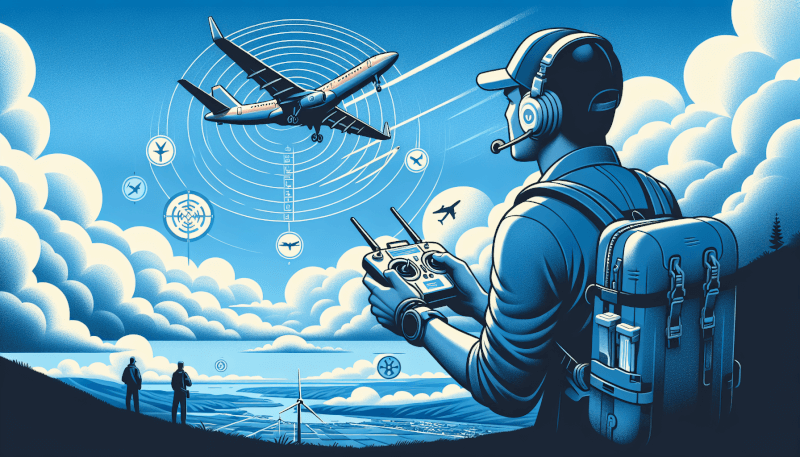In today’s age of technology, drones have become increasingly popular for both recreational and professional use. However, with the growing number of drones taking to the skies, the risk of mid-air collisions is also on the rise. To ensure the safety of both drone operators and the general public, it is crucial to understand the best ways to prevent and handle such incidents. This article will explore effective strategies and guidelines to avoid mid-air collisions with drones, providing valuable insights to all drone enthusiasts and promoting a safer airspace.

Educate and Raise Awareness
Pilot Education and Training
To prevent mid-air collisions with drones, it is crucial to prioritize pilot education and training. As drones become increasingly popular, it is essential for drone operators to fully understand the rules and regulations surrounding their use. By providing comprehensive training programs that cover topics such as airspace rules, safety precautions, and emergency procedures, drone pilots can develop the necessary skills and knowledge to operate their drones in a responsible manner.
Public Awareness Campaigns
Another effective way to prevent mid-air collisions is through public awareness campaigns. These campaigns can help educate the general public about the risks and regulations associated with drone use. By disseminating information through various channels such as social media, television, and community events, individuals will be more informed about the importance of responsible drone operation. This increased awareness can encourage safe and responsible behavior among both drone operators and the general public, reducing the likelihood of mid-air collisions.
Drone Registration and Identification
Implementing a drone registration and identification system is crucial for enhancing safety and accountability in the drone industry. By requiring all drone operators to register their drones and affix visible identification markings, it becomes easier to identify and track drones in the airspace. This system helps authorities quickly identify the operators responsible for any potential mid-air collisions and take appropriate action. Additionally, it encourages responsible drone use, as operators are more likely to adhere to regulations when their identity is easily traceable.
Encouraging Responsible Drone Use
Promoting responsible drone use is vital in preventing mid-air collisions. This can be achieved through the dissemination of guidelines and best practices for safe drone operation. Drone manufacturers and industry associations can play a significant role in educating users about important safety considerations, such as maintaining line of sight, respecting airspace restrictions, and conducting pre-flight checks. By encouraging responsible behavior, drone operators can minimize the risk of mid-air collisions and ensure the overall safety of the airspace.
Implement Regulations and Guidelines
Mandatory No-Fly Zones
Establishing mandatory no-fly zones in areas where mid-air collisions pose a significant risk is crucial to preventing accidents. These no-fly zones can include sensitive areas such as airports, military installations, and crowded public spaces. By clearly defining these restricted zones and enforcing strict penalties for violations, drone operators will be deterred from entering prohibited airspace and increasing the risk of mid-air collisions.
Height and Distance Restrictions
Implementing height and distance restrictions is another effective measure in preventing mid-air collisions. By setting maximum altitude limits and defining the maximum distance a drone can fly from its operator, the risk of collisions with other aircraft is significantly reduced. These restrictions ensure that drones operate within a safe range and maintain a clear line of sight, avoiding potential accidents in the airspace.
Traffic Management Systems
Developing and implementing traffic management systems specifically designed for drones is essential for preventing mid-air collisions in complex airspace environments. These systems would allow for real-time monitoring of drone activity and enable effective coordination between drone operators and other airspace users. By integrating drones into existing air traffic control systems, potential conflicts can be identified and resolved promptly, minimizing the risk of mid-air collisions.
Geofencing Technology
The use of geofencing technology plays a significant role in preventing mid-air collisions. Geofencing enables the creation of virtual boundaries within which drones are restricted from entering without proper authorization. This technology can block drone operation in restricted airspace or areas with high levels of aerial traffic, further reducing the likelihood of mid-air collisions. By integrating geofencing capabilities into drones and enforcing their usage, operators are guided to operate within designated and safe areas.

Enhance Air Traffic Control Systems
Real-time Tracking and Monitoring
To prevent mid-air collisions, it is essential to enhance air traffic control systems with real-time tracking and monitoring capabilities for drones. By integrating drones into existing air traffic management systems, air traffic controllers can have a comprehensive view of the airspace, ensuring safe separation between drones and other aircraft. Real-time tracking and monitoring allow for prompt identification of potential conflicts, enabling timely intervention to prevent mid-air collisions.
Integration of Drone Tracking
Integrating drone tracking technology into existing air traffic control systems is crucial for effective airspace management. By tracking the location, altitude, and movement of drones, air traffic controllers can have a complete picture of the airspace and identify any potential conflicts. This integration enables enhanced coordination between drones and manned aircraft, ensuring safe and efficient operations while minimizing the risk of mid-air collisions.
Improved Communication Systems
Effective communication systems are vital for preventing mid-air collisions with drones. By enhancing communication channels between drone operators, air traffic controllers, and other airspace users, potential conflicts can be identified and resolved in a timely manner. Implementing standardized communication protocols and utilizing advanced technologies, such as data link communications, can ensure efficient and reliable communication, reducing the risk of miscommunication and mid-air collisions.
Develop and Enforce Drone Standards
Required Safety Features
To prevent mid-air collisions, drones should be equipped with mandatory safety features. These features can include collision avoidance systems, GPS tracking, and altitude limiters. By enforcing the inclusion of these safety features in drone design and manufacturing, the risk of mid-air collisions can be significantly reduced. Furthermore, continuous research and development in drone technology can lead to the identification and implementation of additional safety features that enhance collision prevention capabilities.
Certification and Testing Processes
Implementing certification and testing processes is necessary to ensure that drones meet specific safety standards. By establishing rigorous testing procedures for drones before they are allowed to enter the market, manufacturers will be incentivized to produce drones that adhere to stringent safety requirements. Certification processes can verify that drones meet safety criteria, and testing programs can assess their performance in real-world scenarios. This comprehensive approach guarantees that drones are built and operated with safety as a top priority, reducing the risk of mid-air collisions.
Strict Manufacturing Guidelines
Enforcement of strict manufacturing guidelines is essential to prevent mid-air collisions. By implementing regulations that dictate the quality control processes and standards for drone manufacturers, defective or faulty drones can be minimized. These guidelines can cover aspects such as materials used, manufacturing processes, and quality assurance procedures. Strict adherence to these guidelines ensures the production of reliable and safe drones, significantly reducing the risk of mid-air collisions due to mechanical failures or manufacturing defects.

Promote Collaboration Between Stakeholders
Government and Aviation Authorities
Promoting collaboration between government entities and aviation authorities is crucial for preventing mid-air collisions with drones. By working together, these stakeholders can establish comprehensive regulations and enforce them effectively. Additionally, collaboration can lead to the development of policies that encourage responsible drone use and the allocation of resources to enhance safety measures. Strong cooperation between government and aviation authorities ensures a cohesive approach to airspace management, reducing the risk of mid-air collisions.
Drone Manufacturers
Collaboration with drone manufacturers is essential for preventing mid-air collisions. By engaging with manufacturers, regulatory bodies can establish industry standards and guidelines to enhance safety features and reduce risks. Manufacturers can also actively contribute by developing and implementing technological solutions, such as collision avoidance systems and sense and avoid technology, that significantly reduce the risk of mid-air collisions. Close collaboration between regulatory bodies and manufacturers fosters a culture of safety and innovation within the drone industry.
Commercial Drone Operators
Collaboration with commercial drone operators is crucial to prevent mid-air collisions during commercial operations. By involving these operators in the development of regulations and guidelines, their experience and insights can be leveraged to ensure practical and effective safety measures. Additionally, collaboration can lead to the implementation of training programs and best practices specific to commercial drone operations, ensuring that operators are adequately prepared to prevent mid-air collisions in their day-to-day activities.
Airline Industry
Promoting collaboration between the drone industry and the airline industry is vital to prevent mid-air collisions. By fostering communication and cooperation, potential conflicts between drones and manned aircraft can be minimized. Collaboration can lead to the development of protocols for safe interaction between drones and aircraft, as well as the establishment of designated flight corridors for drones. By working together, the drone and airline industries can ensure the safety of the airspace and reduce the risk of mid-air collisions.
Advancements in Drone Technology
Collision Avoidance Systems
Continued advancements in collision avoidance systems are crucial for preventing mid-air collisions with drones. These systems use various sensors, such as cameras, radar, and lidar, to detect and avoid potential obstacles in the drone’s flight path. By equipping drones with collision avoidance technology, operators can rely on automated systems to detect and respond to other aircraft, buildings, or objects, significantly reducing the risk of mid-air collisions.
Sense and Avoid Technology
Sense and avoid technology is another significant advancement in drone technology that aids in preventing mid-air collisions. This technology enables drones to detect and actively avoid other aircraft, even in dynamic and complex environments. Equipped with sensors and artificial intelligence algorithms, drones with sense and avoid capabilities can make real-time decisions to alter their flight path and avoid potential collisions. Implementing this technology enhances the overall safety of drone operations and mitigates the risk of mid-air collisions.
Automatic Dependent Surveillance-Broadcast
Automatic Dependent Surveillance-Broadcast (ADS-B) is a technology that allows aircraft and drones to transmit their position, altitude, and velocity information to other vehicles and air traffic control. By integrating ADS-B into drones, air traffic controllers can have real-time information on the location and movements of drones in the airspace. This technology enhances situational awareness, enabling proactive collision avoidance measures and reducing the risk of mid-air collisions.
Detect and Avoid Sensors
The development of detect and avoid sensors is crucial for preventing mid-air collisions with drones. These sensors use advanced technologies, such as radar and lidar, to detect and track other aircraft in the vicinity of a drone. By equipping drones with detect and avoid sensors, operators are provided with real-time information on potential obstacles, allowing them to take appropriate actions to avoid mid-air collisions. These sensors serve as an additional layer of safety, ensuring the safe coexistence of drones and other airspace users.

Establish Incident Reporting and Investigation Procedures
Standardized Reporting Protocols
Standardized reporting protocols are essential for efficient incident reporting and investigation procedures. By establishing clear and consistent guidelines for reporting mid-air collisions and near-miss incidents involving drones, authorities can gather accurate and comprehensive data. These protocols enable the identification of trends and patterns, leading to targeted measures for preventing future mid-air collisions.
Prompt Investigation and Analysis
Prompt investigation and analysis of mid-air collision incidents involving drones are crucial for identifying root causes and implementing appropriate preventive measures. By conducting timely investigations and analysis, authorities can gather critical information and insights that aid in understanding the circumstances leading to the collision. This information can then inform the development of targeted strategies and technologies to prevent future incidents.
Information Sharing and Lessons Learned
Information sharing and the dissemination of lessons learned are vital for preventing mid-air collisions. By sharing incident reports, analysis, and best practices with relevant stakeholders, valuable insights can be disseminated throughout the drone industry. This proactive approach facilitates continuous improvement and helps operators and manufacturers implement effective preventive measures. By learning from past incidents, the industry can collectively work towards ensuring the safety of the airspace and the prevention of mid-air collisions.
Implement Effective Enforcement Measures
Identification and Tracking Implementation
Implementing effective identification and tracking measures is crucial for enforcing regulations and deterring unsafe drone operations. By requiring drones to be equipped with identification markers, registration numbers, or electronic identification systems, authorities can easily identify and monitor drones in the airspace. This enables swift enforcement action in the event of mid-air collisions or other safety violations, ensuring the accountability of drone operators and deterring unsafe behavior.
Strict Penalties for Violations
Strict penalties for violations play a vital role in preventing mid-air collisions. By establishing and enforcing penalties for non-compliance with regulations, authorities can effectively deter unsafe drone operations. The prospect of heavy fines, license suspensions, or criminal charges motivates drone operators to prioritize safety and adhere to the rules. The imposition of strict penalties sends a clear message that mid-air collisions and endangering the airspace will not be tolerated.
Surveillance and Monitoring Systems
Installing surveillance and monitoring systems specifically designed to detect and track drones is essential for effective enforcement measures. These systems can utilize radar, cameras, or other technologies to identify and monitor drone activity in real-time. By employing a comprehensive surveillance and monitoring network, authorities can proactively detect unsafe operations, quickly intervene to prevent mid-air collisions, and gather evidence for enforcement actions.

Collaborative Research and Development
Addressing Emerging Risks and Challenges
Collaborative research and development efforts are essential for addressing emerging risks and challenges in the drone industry. By bringing together experts from various fields, including engineering, aviation, and regulation, stakeholders can identify potential threats and develop innovative solutions. Research can focus on improving collision avoidance systems, enhancing drone tracking capabilities, and addressing emerging concerns such as swarming drones. Through collaborative efforts, industry-wide safety standards can be established to prevent mid-air collisions.
Improving Drone Safety Technologies
Continuous improvement of drone safety technologies is critical to preventing mid-air collisions. Through collaborative research and development, stakeholders can focus on enhancing existing safety features and introducing new technologies. This can include advancements in collision avoidance systems, improved sense and avoid capabilities, and the integration of artificial intelligence for enhanced decision-making. By prioritizing research and development efforts, the industry can stay at the forefront of safety innovation and minimize the risk of mid-air collisions.
Testing and Evaluation Programs
Establishing comprehensive testing and evaluation programs is essential to ensure the safety and effectiveness of new drone technologies. Through collaboration between manufacturers, regulators, and research institutions, these programs can assess the performance and reliability of safety features and collision prevention systems. Testing may involve simulated scenarios, controlled airspace environments, or even live demonstrations. By subjecting drones and related technologies to rigorous evaluation, potential weaknesses or limitations can be identified and addressed, reducing the risk of mid-air collisions.
Identify and Address Cybersecurity Risks
Protection against Unauthorized Access
Cybersecurity plays a critical role in preventing mid-air collisions with drones. Unauthorized access to drone systems can result in compromised flight operations and potential collisions. Implementing robust cybersecurity measures, such as secure authentication protocols and encryption, protects against unauthorized access and ensures the integrity of data transmission. By safeguarding drone systems from cyber threats, the risk of mid-air collisions due to malicious interference can be significantly mitigated.
Encryption and Secure Communication
Encryption and secure communication protocols are essential for preventing unauthorized interception and manipulation of drone communication. By employing encryption algorithms and secure communication channels, drone operators can ensure that control signals and data transmissions remain confidential and tamper-proof. Secure communication prevents external manipulation of drones, reducing the risk of mid-air collisions caused by unauthorized control or compromised navigation.
Firmware and Software Updates
Regular firmware and software updates are crucial for addressing potential vulnerabilities in drone systems. By promptly addressing identified security weaknesses or software bugs, drone manufacturers can enhance the cybersecurity capabilities of their products. These updates can improve encryption algorithms, strengthen firewalls, or patch potential entry points for cyber attacks. Ensuring that drone systems are using the latest firmware and software versions mitigates the risk of cyber threats that can lead to mid-air collisions.
In conclusion, preventing and handling mid-air collisions with drones requires a multi-faceted approach that encompasses education, regulations, technological advancements, collaboration, incident reporting, enforcement, research and development, and cybersecurity measures. By implementing comprehensive strategies, stakeholders can work together to ensure the safe integration of drones into the airspace, reducing the risk of mid-air collisions and promoting a secure and thriving drone industry.


